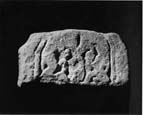Select a site alphabetically from the choices shown in the box below. Alternatively, browse sculptural examples using the Forward/Back buttons.
Chapters for this volume, along with copies of original in-text images, are available here.
Object type: Part of lower cross-arm [1]
Measurements: H. 15 cm (5.9 in); W. 27 cm (10.75 in); D. 15 cm (5.9 in)
Stone type: Coarse-grained, massive yellow sandstone
Plate numbers in printed volume: Pl. 83.425-428
Corpus volume reference: Vol 1 p. 96
(There may be more views or larger images available for this item. Click on the thumbnail image to view.)
The type of head is indeterminate. The carved faces are surrounded by a wide outer flat-band and fine inner roll moulding.
A (broad): The lower portion of two animals can just be deciphered. They appear to be rearing with front legs crossed, and their tails pass between their legs and are interlaced.
B (narrow): Variation of half pattern D including a pattern F loop.
C (broad): The terminals of a pattern which seems to be C with outside strands.
D (narrow): Alternating half pattern D with bar terminals.
The outer flat-band and fine inner roll mouldings seem to be a feature of the Hart group (see also Hurworth 1). The origin of these paired beasts is no doubt the Yorkshire crosses such as Aldborough (Collingwood 1927, fig. 32). However, they spread to Lindisfarne (no. 2) and Hexham (no. 5); Adcock (1974, 333-4) sees a link with the work of the Durham grave-cover (no. 11) in the repertoire of plaits in this piece. It is part of the same group as Hart 4 and 5 (Introduction, p. 18).



